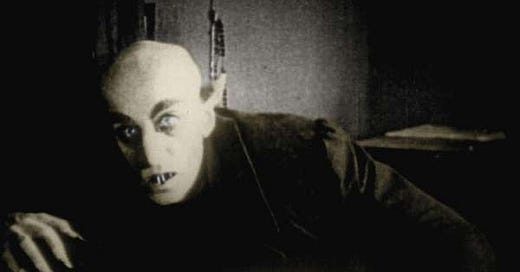Why do some monsters always follow the rules?
Vampires have to be invited in, and faeries follow the letter of their contracts, but what does it all represent? And why does it matter?
Recently I’ve heard a few rumblings about the age-old question about vampires needing to be “invited in” before they can enter a home, and the larger question of “why some monsters are such sticklers for the rules.”
[Image: Werner Herzog Film produktion]
I’ve said this before, but the vampire a near-universal myth about people who walk like us and talk like us, but secretly prey upon us while trying to blend in with the rest of the community. In short: a monster.
And the vampire is a monster who, in myth, represents the parasites among us who do ill deeds, but do not break the rules.
In the olden days, this represented something specific: someone in the community who follows along “by day” but commits ill deeds under the guise of a rule-following fellow human being (hence their deeds “in the light of day” being a form of revelation that, even while they’re technically obeying social contract, they’re still doing harm.)
And today? Well, ask Bram Stoker: what would a vampire do differently in the modern world? Would they skirt the law, commit crimes in the open, and hide in the shadows?
Or, would they be the ones following the rules, as part of the ruling class, following the letter of the law rather than its intent?
It is often said that art imitates life, and good art often teaches us a lot about ourselves. And look at the monsters we have in real life.
A law breaking criminal usually has a better chance of being caught the more damage they do. If you rob a bank, you might vanish, but if you rob several you’re eventually going to rile powerful people who will expend considerable resources to stop you.
But if you are those powerful people? The law if a tool at your disposal. Look at history:
Credit: Western History/Genealogy Department, Denver Public Library.
The Ludlow Miners’ Strike of 1914, where coal companies hired detectives to oppose strikers, which ultimately led to the massacre of mine workers who refused to work in unsafe conditions.
This was lawfully sanctioned event. Governor Elias M. Ammons called in the national guard, who sympathized with company management. People were killed, including women and children, which caused such an outrage that hundreds of mine workers attacked numerous mines, and public outcry turned against the Rockefellers themselves.
Funnily enough, it was the illegal attacks in retaliation that finally made headlines, swayed public opinion, and caused reforms.
In fact, a United States Commission on Industrial Relations, called the CIR, headed by labor lawyer Frank Walsh, conducted hearings in Washington, DC, collecting information and taking testimony from all the principals.
This included John D. Rockefeller Sr. who testified that, even after knowing that guards in his pay had committed atrocities against the strikers, "would have taken no action" to prevent his hirelings from attacking the miners. The commission's report endorsed many of the reforms the unions sought, and provided support for bills establishing a national eight-hour workday and a ban on child labor.
[For more information, read The Day Wall Street Exploded by Beverly Gage, and The Age of Industrial Violence by Graham Adams, Jr.]
Let me stress again: the bad guys here were the ones acting legally. And the good guys only got their safety concerns addressed once outraged workers in retaliation broke the law.
History is full of such examples, from Robin Hood being an “Outlaw” against a corrupt King John, to Martin Luther King, Jr, who was legally arrested several times fighting for Civil Rights.
And so, while the instinctive reaction is to assume “good guys obey the rules and bad guys do not” history still leaves us a little room for a much more “rule-abiding” monster.
And the vampire is not alone — faeries obey their contracts, and even djinn will only twist the words of a wish, while following it “to the letter” — and this is by design. Monsters who follow the rules “to the letter” while still committing wrongdoings are absolutely a part of real life.
So: when you ask yourself “why do some monsters follow certain rules” remember the real monsters among us. Not all villains are rule-breakers. Some, in fact, control the rules themselves. They are the real life vampires; parasites who do terrible harm, but follow the law. You’ll never see them refuse a settlement offer or go refuse to go to court — but they will lawyer themselves out of it, the same way a vampire says “it’s not my fault, they invited me in.”
There’s a lesson to be learned there.





